Black Abalone Shell, Haliotis cracherodii
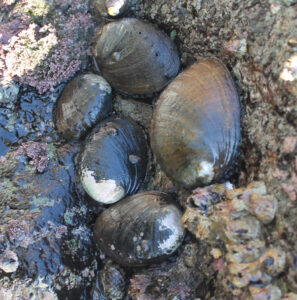
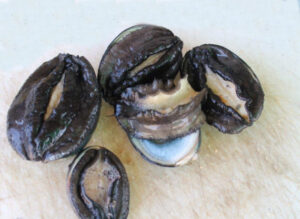
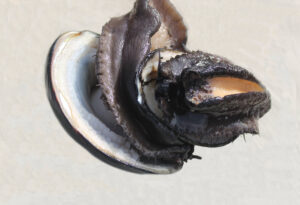 Black Abalone Shell, Haliotis cracherodii. Abalone collected from coastal waters off Bahía Santa Rosalillita, Baja California, September 2015. Collection, identification and photo courtesy of Barry Mastro, Escondido, California.
Black Abalone Shell, Haliotis cracherodii. Abalone collected from coastal waters off Bahía Santa Rosalillita, Baja California, September 2015. Collection, identification and photo courtesy of Barry Mastro, Escondido, California.
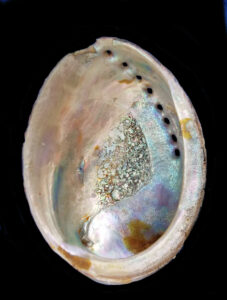
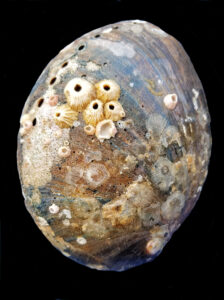 Black Abalone Shell, Haliotis cracherodii. Size: 18.0 cm (7.1 inches) x 13.4 cm (5.3 inches). Shell collected from coastal waters off San Diego, California, August 2018. Collection, photograph and identification courtesy of Bob Hillis, Ivins, Utah.
Black Abalone Shell, Haliotis cracherodii. Size: 18.0 cm (7.1 inches) x 13.4 cm (5.3 inches). Shell collected from coastal waters off San Diego, California, August 2018. Collection, photograph and identification courtesy of Bob Hillis, Ivins, Utah.
Phylogeny: The Black Abalone, Haliotis cracherodii (Leach, 1814), is a sessile gastropod mollusk that is a member of the Haliotidae Family of Abalones. The genus Haliotis is one of ten genera in this family, and one of sixty-nine species in this genus. They are known in Mexico as Abulón Negro. There are currently two accepted subspecies for this species- Haliotis cracherodii californiensis and Haliotis cracherodii cracherodii .
Description: Black Abalone have dark brown, dark green, dark blue or almost black smooth oval shells with a pale pinkish iridescent green interior. The mantle, foot and tentacles are black. The shells are plump and the exterior is smooth with very fine spiral lines. Along their left sides, they have five to nine open respiratory pores, utilized for breathing, waste removal, and reproduction. The holes do not project above the outside surface of the shell and in some shells all of the holes are closed. Black Abalone are the smallest abalone found in Mexican waters. They reach a maximum of 22 cm (8.5 inches) in length, 16 cm (6.4 inches) in height, and 800 grams (1.75 pounds) in weight, with most specimens being half that size.
Habitat and Distribution: Black Abalone are found on, and under, rocks and within crevasses. They are found along shorelines that are exposed to moderate to high surf. They range from the high tide line to depths up to 6 m (20 feet). Primarily at night, with the aid of a muscular foot, they have the ability to move freely over rock structures. They are very tolerant of extreme variations in temperature, water salinity, moisture and wave action. Black Abalone are a temperate Eastern Pacific species. In Mexican waters the Black Abalone has a limited range, being found only along the entire West Coast of the Baja Peninsula. They are rare south of Bahia Tortugas, Baja California Sur.
Ecology and Behavior: Black Abalone are herbivorous grazers that consume various kinds of algae and kelps. Black Abalone have separate sexes and reproduce via the simultaneous broadcasting of eggs and sperm into the water when conditions are correct. Successful spawning requires that numerous individuals be grouped in close proximity. The eggs hatch within one day and the larvae are free-swimming for five to fourteen days, at which time they settle out on the hard bottom surface. At that point they metamorphose into the adult form, develop a shell, and attach themselves to rocks. Juveniles up to 10 cm (4.0 inches) in length mainly reside in rocky crevices and feed primarily on benthic diatoms, bacterial films and algae found attached to coral. The juveniles are vulnerable to predation. As they increase in size they are able to emerge from their sheltered habitat and search out more desirable locations and food sources. Black Abalone are preyed upon by humans, crabs, lobsters, sea stars, sea otters, and various fishes. They also compete for space with various sea urchins. They reach sexual maturity in three to seven years. They have life spans of up to seventy-five years.
Black Abalones have been harvested along the California Coast for at least 10,000 years and have been a mainstay of the diets of Native Americans. The shells have been used to make fish hooks, beads, ornaments and have been used as a trade currency. In Mexico, the Black Abalone has not been the primary abalone of commercial focus due to their relatively small size. However, the commercial harvests of the Green Abalone, Haliotis fulgens, and the Pink Abalone, Haliotis corugata, have significantly declined lately enhancing the commercial interest in the Black Abalone, and they have become important to local economies. At present, in Mexico, there is a total allowable catch limit for Black Abalones, but the regulation is poorly monitored or enforced and due to the high price for the meat, poaching occurs. They are presently vulnerable to disease, overfishing, illegal harvest (due to the high prices for their meat), human coastal development and related habitat destruction, and to oil spills. From a conservation perspective the Black Abalone is currently listed as CRITICALLY ENDANGERED. The harvesting of the Black Abalone is currently illegal in California but they are still fished commercially in Mexico. They have been significantly plagued by Withering Syndrome, a common fatal infection that affects the digestive organs of the abalone, causing epipodial discoloration, loss of appetite, weight loss and atrophy of the foot muscle. They quickly lose their ability to adhere to substrate and die. This has caused mass mortalities and reduced the overall populations by over 3 million individuals and up to 80% in most locations and eliminated the populations in some areas. Withering Syndrome has been documented to extend as far south as Cedros Island off the central West Coast of Baja. The commercial catch in California started in 1968 and peaked in 1973 at 1.6 million pounds, then declined to essentially zero in the mid-1990s when the fishery was closed in 1993. Efforts are currently ongoing to restore stocks by transplantation from distant populations, but to date has had mixed results.
Synonyms: Haliotis cracherodii f. imperforata, Haliotis cracherodii var. californiensis, Haliotis cracherodii var. holzneri, and Haliotis cracherodii var. lusus.